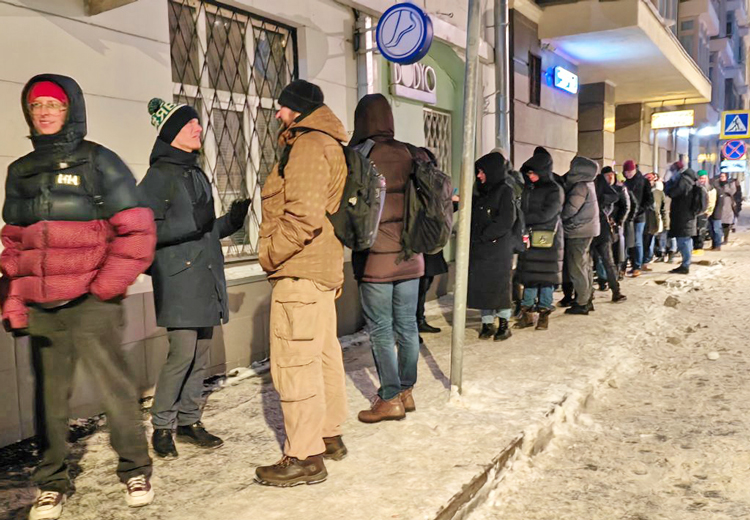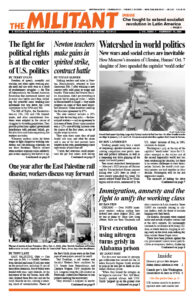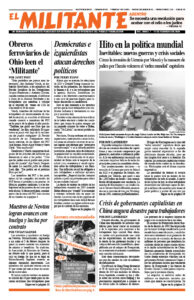Working people today face a world of deepening capitalist disorder and escalating competition over profits, markets and political influence, as well as a deepening war drive gripping all the major rival world powers.
Two recent watershed developments — Moscow’s 2022 invasion of Ukraine and the Tehran-backed Hamas pogrom killing over 1,200 Jews in Israel — have sharply intensified this trend. The march toward World War III by Washington and its rivals, announced by the U.S. rulers’ invasion of Iraq in 1991, continues to deepen.
Washington’s grip at the top of the capitalist “world order” since the U.S. rulers emerged as the victors out of the second imperialist world war has been weakening for decades, but there is no serious challenger to their domination. Instead, the world’s rival capitalist powers are tied together in their decline. Washington will be the last imperialist empire.
The necessity of halting the drive toward war lies in the hands of working people worldwide. Out of today’s struggles the working class will develop a leadership capable of leading us in our millions to take political power and end once and for all dog-eat-dog capitalism and its drive to war.
Increasing numbers of workers see the need to use their unions to fight, to affect the future. This is reflected both in the increased number of strikes in the U.S. and in workers’ openness to the idea they can change history.
The U.S. rulers are being drawn more deeply into conflicts in the Middle East as they try to impose the stability their class needs to exploit the region.
Following Moscow’s attempt to conquer Ukraine, “political and military alignments — ‘spheres of influence’ that had shaped the global imperialist order since Washington emerged as the dominant power coming out of World War II — are being shaken and new alliances between competing states put together,” explain Jack Barnes, Mary-Alice Waters and Steve Clark in The Low Point of Labor Resistance Is Behind Us: The Socialist Workers Party Looks Forward.
Tensions between Washington on one side and Beijing, Moscow and Tehran on the other have sharpened over the past two years.
Ukraine, Israel fight back
In Ukraine working people are determined to defend their country’s independence. They’ve been central to driving back Moscow’s attempt to conquer the country. Millions worldwide are inspired by their resistance as the first major ground war in Europe since World War II continues to rage.

As its own arsenal has been depleted, Moscow has turned to drones from Tehran and missiles from Pyongyang to continue its murderous assaults on civilians in cities and towns across Ukraine.
Hamas’ Oct. 7 massacre was the worst single pogrom against Jews since the Nazi Holocaust. It was met with widespread revulsion by working people worldwide. The war launched by Israel is seeking to crush Hamas. It aims to prevent the terror group from carrying out its avowed goal of organizing ever-more murderous assaults on Jews until they are all killed or driven from the region.
The Oct. 7 slaughter was orchestrated by the bourgeois clerical regime in Tehran, the main reactionary power in the Middle East. Its leaders say their goal is the destruction of Israel and the elimination of Jews. From Hezbollah in Lebanon to its proxy militias in Syria and Iraq, and the Houthis in Yemen, Tehran has funded military forces across the region to advance its interests and launch assaults on Israel. At the same time, it tries to keep the scope of these attacks in check to avoid a major response.
The rise of Jew-hatred in the U.S. and elsewhere since the Oct. 7 pogrom underlines both the importance of defending Israel’s right to exist as a refuge for the Jewish people and the virulence of Jew-hatred under capitalism. In times of deep crisis the capitalist rulers will turn to fascist gangs and Jew-hatred in an effort to crush the unions and maintain their rule. First and foremost, this battle will be fought out on U.S. soil.
Israel was established as a haven for Jews after the Stalinist betrayal of revolutionary opportunities across Europe, the horror of the Holocaust and the refusal of Washington and other “democratic” imperialist powers to admit Jews attempting to flee Nazi terror.
U.S. airstrikes hit Tehran’s militias
Militias allied with the Iranian rulers have carried out more than 160 attacks on U.S. forces in the region since Hamas’ pogrom. Their aim is to pressure Washington to push Israel into a cease-fire and leave Hamas intact.
President Joseph Biden’s administration launched airstrikes and missile attacks Feb. 2 against militias in Iraq and Syria that are organized by Tehran’s Islamic Revolutionary Guard Corps.
Washington says this was in response to a Tehran-backed militia drone strike on a U.S. base in Jordan that killed three U.S. soldiers Jan. 28.
The U.S. rulers gave the regime in Iran enough notice to allow it to move its military forces out of the line of fire in Iraq and Syria. The Biden administration says U.S. assaults on the militias will continue, but that Washington will avoid airstrikes on Iran.
The rulers in the U.K. sent warplanes to join Washington’s attack against 13 Houthi military bases a day later, the third such joint operation against the Houthis in two weeks. Since mid-November, the Tehran-sponsored Houthis have seized one ship and launched more than 30 rocket and drone attacks on cargo vessels and warships passing through the Red Sea, choking off a key global shipping channel.
The Iranian regime is pushing to acquire nuclear weapons to bolster its position against Israel and to extend its reach in the Middle East and beyond. But Tehran faces a significant obstacle — working people inside the country. Sizable protests since 2017 have reflected the deep opposition to Tehran’s adventures abroad.
Secretary of State Antony Blinken arrived in the region Feb. 5 to hold talks with the rulers of Saudi Arabia, Egypt, Qatar, Israel and the Palestinian Authority in the West Bank. Washington wants to push the Israeli government into a long-term cease-fire, backing off from its war to destroy Hamas.


